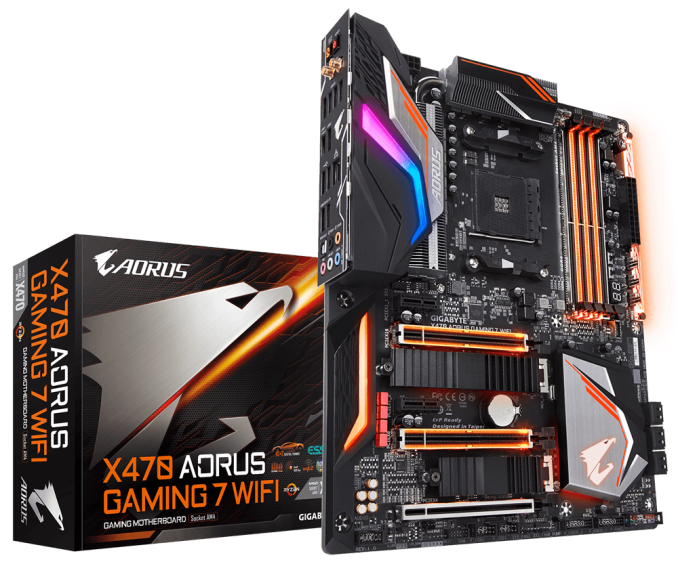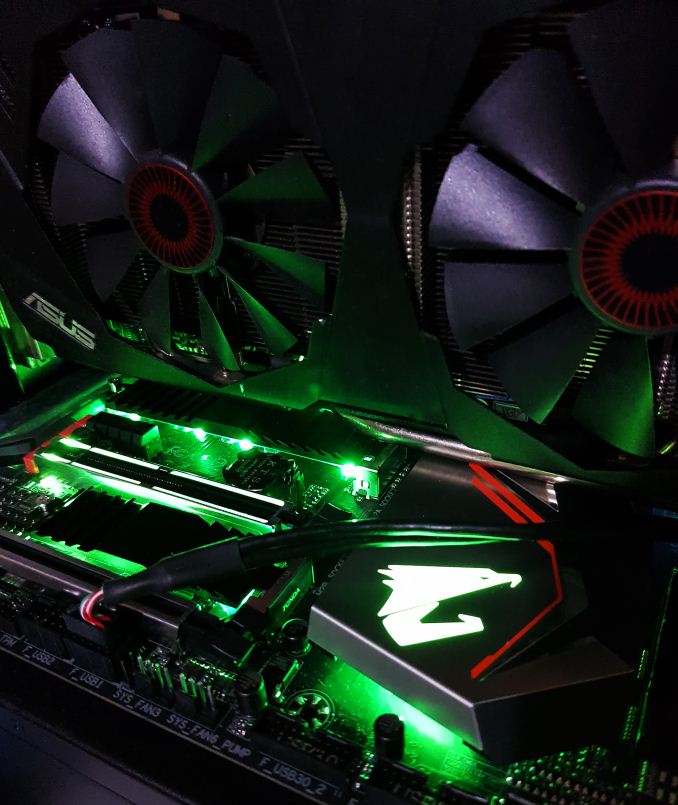The GIGABYTE X470 Gaming 7 Wi-Fi Motherboard Review: The AM4 Aorus Flagship
by Gavin Bonshor on July 26, 2018 8:00 AM EST- Posted in
- Motherboards
- AMD
- Gigabyte
- AORUS
- Ryzen
- X470
- Ryzen 2
- Gaming 7 Wi-Fi
- Gaming 7
GIGABYTE X470 Aorus Gaming 7 Wi-Fi Conclusion
The GIGABYTE X470 Aorus Gaming 7 Wi-Fi has a launch list price of $240 at Amazon US which makes it the most expensive GIGABYTE AM4 motherboard on the market. However, it has the current ‘flagship’ status and has cheaper launch pricing compared to the similarly featured ASUS X470 ROG Crosshair VII Hero ($280) and the MSI X470 Gaming M7 AC ($260). In relation to official memory support, the X470 Gaming 7 Wi-Fi actually has support for faster memory on paper with DDR4-3600.
Overall performance while being compared to previously tested AM4 boards (X370/B350) with our Ryzen 7 1700 ($299) was relatively decent in terms of computational benchmarks, as well as within our DPC latency and other system performance tests. The lackluster gaming results brings the overall results down, however the margins are theme.
While the Aorus brand is primarily targeted towards the gaming crowd, there’s certainly enough overall to make this a well-rounded offering catering to enthusiasts and other power users, as well as gamers. The power delivery has a solid design, and the biggest improvement over the first generation of AM4 boards is the large VRM heatsink which seems a bigger and appreciated improvement over the first generation of AM4 boards released; the design has shades of the 'good old days'. When under full load, it easily coped with the loads without any issues whatsoever; a testament to the change implemented from X370 and one which will be welcomed by many.
Another set of welcomed features is dual BIOS which offers redundancy when flashing to a newer revision; blackouts can happen and I have experienced one myself when updated an older board, let’s just say it wasn’t usable and it may/may not have made the scrap pile. The other is dual NVMe capable PCIe 3.0 x4 M.2 slots which both include a separate and stylish looking black metal heatsink. I have always gone with a function over style preference when selecting new components but having both is a major win in today’s overcrowded RGB all over everything to sell it market.
The board features a full black PCB and has oodles of RGB LED lighting integrated into various zones across the board, making it one of the most customizable from a lighting perspective thanks to the Aorus RGB Fusion software. This makes the board aesthetically pleasing, but it has to be said that the LEDs are rather overpowering and actually detracts from the overall style; of course, this is down to personal preference.
The X470 Gaming 7 Wi-Fi is made even more appealing by its good range of connectivity and choice of controllers including a total of ten USB ports. The rear panel also has a single Intel I211-AT controlled Gigabit LAN port as well as two gold screw on points to make use of the 2T2R 802.11ac Intel based integrated Wi-Fi. GIGABYTE has put a real focus on Wi-Fi, not just in the name, but by adding an the latest Intel 9260NGW 802.11ac Wi-Fi Wave 2 module capable of supporting speeds of up to 1.73 Gbps. The onboard audio comes via the Realtek ALC 1220-VB codec and an ESS SABRE ES9018Q2C digital to analogue converter to further enhance things from an auditory standpoint.
The GIGABYTE X470 Aorus Gaming 7 Wi-Fi is very alluring for gamers and enthusiasts looking to build a powerful AMD based gaming system around Ryzen based CPUs such as the Ryzen 7 1800X ($350) or brand-new Ryzen 7 2700X ($329) eight core processors. Any fatigue felt through the original Ryzen launch in affiliation to launch woes with memory compatibility has been alleviated by AMD and the vendors thanks to faster memory support out of the box; GIGABYTE showing official support for DDR4-3600 when boards from other vendors show DDR4-3466 on launch day offerings is a big plus in the favor of GIGABYTE/Aorus.
Everything summarized, the X470 Gaming 7 Wi-Fi ticks a vast majority of the boxes in relation to compatibility, connectivity and quality throughout and for $240 at launch, it surely has to make the shortlist for any AMD based single or dual graphics card wielding gaming system.
Other AnandTech Ryzen Coverage
- The AMD 2nd Gen Ryzen Deep Dive: 2700X, 2700, 2600X, and 2600 Tested
- The AMD Ryzen 5 2400G and Ryzen 3 2200G APU Review: Marrying Vega and Zen
- The AMD Ryzen 3 1300X and Ryzen 3 1200 CPU Review: Zen on a Budget
- The AMD Ryzen 5 Review: All Ryzen 5 CPUs Tested
- The AMD Zen and Ryzen 7 Review: A Deep Dive on 1800X, 1700X and 1700
- $255 - MSI X370 XPower Gaming Titanium [review]
- $240 - GIGABYTE X470 Aorus Gaming 7 Wi-Fi [this review]
- $175 - GIGABYTE AX370-Gaming 5 [review]
- $160 - ASRock X370 Gaming-ITX/ac [review]
- $110 - Biostar X370GTN [review]
- $98 - MSI B350 Tomahawk [review]
- $90 - ASRock AB350 Gaming K4 [review]












29 Comments
View All Comments
vkristof - Friday, July 27, 2018 - link
So, it's middle of 2018, we a newish top-end AM4 "chipset" - WHY do we still only have two USB 3.1 10 Gbps ports on the rear panel?And why are they STILL not using USB 3.1 10 Gbps controllers/phys in the X470?
I'm not a gamer AT ALL and I buy cost effective HW AND I still fall for the AM4 "chipset" descriptions that list x amount of USB 3.1 Gen 2/10 Gbps controllers in the B350, B450, B370, B470 "Chipsets".
Why an extrenal Asmedia USB 3.1 Gen2/10 Gbps controoler and not the AMD "chipset" itself???
utmode - Friday, July 27, 2018 - link
instead putting RGB light they could have put more fan connector.Flappergast - Saturday, July 28, 2018 - link
Why is this board get 5% less fps compared to the msi b350 - this board is for high end and 5% is a lot extra if you are looking at SLI - and I dot see why you would not at this price pointMarkPhantasy - Sunday, July 29, 2018 - link
Hi,Thanks for sharing this awesome content.
Have a nice day.
http://intermediateresult2018.online/
Dug - Thursday, August 2, 2018 - link
Can we please get some m.2 and ssd benchmarks along with network benchmarks.And why are you using an older chip on new hardware? Can't Anandtech purchase a 2700x or 2800x?
How about sound? Any measurements or at least some tests would be nice.
4 year old graphics card?
How about tests with both m.2 slots filled with a x16 graphics card to see if there is any performance hit?
Mikewind Dale - Friday, February 1, 2019 - link
"And why are you using an older chip on new hardware? Can't Anandtech purchase a 2700x or 2800x?"Probably because they want to keep their benchmark results inter-comparable. If they already have benchmark scores using a 1700 and an X370, then they want to be able to show how much faster the X470 is than the X370 using the same processor (the 1700).
The purpose of a test bed is to keep every component the same except the one component being reviewed. So that means refraining from frequent upgrades to the test bed. If they constantly upgraded the test bed every time a new product came out, then none of the benchmarks would mean anything.
Oxford Guy - Friday, August 10, 2018 - link
"This is apparent as the X470 Gaming 7 has support for DDR4 memory up to speeds of DDR4-3600"Patriot guaranteed 3400 speed in July of 2017, even on B350 and A320 boards with Ryzen 1. This isn't so impressive, the idea that someone should fork over so much cash for a small bump over that.
As for the heatsink... We all know that ASUS came out with a hybrid water/air VRM sink back in 2013 and Gigabyte also later released the same thing — but only for Intel. Funny how even Threadripper isn't important enough to get the kind of board tech ASUS and Gigabyte gave quad core CPUs, before LED lighting and ugly paint jobs was supposed to substitute for substance.
vikkadhamtan - Saturday, August 18, 2018 - link
<a href="https://www.rsmssbldcresult.in/">RSMSSB LDC Result 2018</a>